Helicopter Cargo Physics Puzzle Game!
My first reaction when I played Flyhard was that I wasn’t going to review it. I had to download PhysX drivers just to run it, the interface was too clunky, and the controls felt terrible. After I finished the game, though, I decided that Flyhard was worth talking about for a few reasons. It does some things really well in terms of elegant physics-based puzzle design, but I wanted to use it as a case study for designing physics-based movement mechanics. Why exactly does Flyhard feel like crap? What could they have done to make it feel better?
Competition Entry
Flyhard was created by Stephen Downey for a Dark Basic programming competition. The timeframe for developing entries was only two weeks, so naturally you’d expect the game to be a little rough around the edges. I view the game more as a prototype than as a product. I think it does a tremendous job as a proof of concept piece.
Physics Puzzles
The physics puzzles in the Flyhard levels are very well done. They require you manipulate the objects in the level in a very natural way; nothing feels forced. All of the puzzle situations can be boiled down to a basic, “I need to get this object over here, but it won’t fit through here” formula. For instance, you might have to let a moving platform push a box for you, or pick up a plank to poke it through a gap if the helicopter won’t fit.
Flyhard only has three levels, which is kind of shame, because I’d really like to see more variety in the level designs (even for a prototype). The scope of the project was certainly limited by the competition time limit, but there are lots of cool things left to do. There’s plenty of leeway here for a complete game based on a fly/pickup design.
Control Issues
The helicopter controls are terrible. They manage to simultaneously feel sluggish at slow speeds, yet too fast and out of control at high speeds. And despite the sluggishness it’s still difficult to perform small, accurate maneuvers. Part of this is due to overall weird physics behavior. I’m not sure how the physics objects have been clamped to 2D, but it produces strange results. Objects are very floaty and generally resist rotation. The helicopter has its rotation locked, too, which feels incorrect when you pick up long, heavy objects.
It would be an interesting design exercise to recreate the simple “fly a helicopter, pick up stuff” mechanic. My implementation would have more dampening, less extreme rotational locking, and a small rope for picking up objects. The rope would add a lot of pleasing overlapping motion and follow-through. Abruptly stopping would produce swaying motions with your cargo, reinforcing the heft of your actions. You would need to be careful to avoid resonance with any swaying motion, which could veer you off course.
I would spend more time tuning impacts, too. The helicopter in Flyhard has high elasticity, which feels completely out of place. Crashing into walls and floors should crunch, not rebound. Finally, I would rescale things. The objects in Flyhard feel small due to their rapid velocity changes and high top speed. A velocity maximum would help to make the helicopter feel larger.
Go Flyhard!
Despite its flaws, I have a lot of respect for Flyhard. It implements its design well past a solid proof concept implementation. The functionality is there completely enough to tell if the game has potential or not. It definitely does. Let’s hope Stephen produces something new (and with more development time)!
Download Flyhard Game (15.5 MB)
You need to the PhysX drivers installed to play the game (yes, even if you don’t have PhysX hardware).
Related Posts:
Peggle! Funny Word, But Fun Game?
There’s something oddly compelling about PopCap’s latest release, Peggle. The game is basically Pachinko: You fire a ball from the top of the screen and watch it bounce around until it hits the bottom. That’s right, watch. The player is given zero influence and interactivity as soon as the ball leaves the starting cannon. All you can do is join the on-screen mascot in watching it plink from peg to peg. If you’re incredibly skilled–or, more probably, just lucky–the ball falls into a moving bucket and you get it back. That’s it. That’s the game. So why is it so addicting?
The Physics of Peggle
The behavior of individual collisions in Peggle is incredibly simplistic. That isn’t necessarily a bad thing; simplistic also means predictable. The complexity of the physics, from the player’s point of view, comes from predicting the ball’s behavior three, four, five bounces out. At some point you’re basically guessing, especially on levels with moving objects.
It is possible to become a better player at Peggle. The game aptly demonstrates this in the Duel Mode, which has multiple difficulty settings for the computer opponent, and the “Zen Ball” powerup in the single-player mode. I really enjoyed the Zen Ball concept. Essentially, the game will calculate an improvement to your shot. It checks the outcome of small variances in your shot angle, and then corrects it to whichever produces the best result. It highlights the fact that even a small change in angle can produce vastly different results over multiple collisions.
Lack of Interactivity
The lack of interactivity in Peggle will probably be frustrating to hardcore players. As a test, I just played for a minute–I clicked just seven times. Compare this to something like an RTS where you’re going to be clicking thousands of times over the course of a game. Keep in mind, though, that PopCap develops casual games. Their primary audience is 40 year-old women (who are probably talking on the phone while playing anyway).
Despite the lack of direct influence on the game, I’ve found that I do pay attention. In fact, it’s hard to look away. The fun of the game emerges by making all kinds of small predictions. You start to get a sense of when your ball is certainly lost, or when it might go in, even while it’s still bouncing around. It’s fun to make a mental prediction halfway through a shot and see if it comes true or not. As your skill progresses, you eventually get to the point where you’re capable of making that prediction when you first fire the shot. I’d be curious to see how good the PopCap developers are at playing Peggle.
Case Study in Polish
As is typical of PopCap titles, Peggle has a high degree of polish. They do a lot of audio-visual things really well, and that certainly adds to the addictive quality of the game. I’m not sure how fun a flat-color prototype of this game type would be without the production backing it up.
I think Peggle makes for an interesting case study in design. Most interesting, to me, is how the game teaches the player to accept failure. Your ball is going to fall off the screen, no matter what you do. In some sense you beat a level by simply failing more slowly. This contrasts starkly with other games where failure only happens once, harshly and irreversibly. I’m looking forward to seeing how well the market receives the game. I can see it doing well with casual players.
Conclusion
For hardcore physics game fans, Peggle is still probably worth checking out. I found it fun in its own right, but I doubt I’ll be playing it for any length of time (as I have with many physics games). There’s no risk in checking it out; the full game is available as a 60-minute demo.
Download Peggle Game (14.1 MB)
Related Posts:
Throw Metal Pies at Ragdoll Clowns (Redux)
Have you ever wanted to swap out a clown’s cream pie with a metal replacement? That next performance would take a grisly–but hilarious–turn for the unexpected. Or, you could do away with the subterfuge altogether and simply lob metal pies at hapless clowns. That would be wrong, and possibly illegal, unless it was a totally awesome video game. Why look! It is!
The Old Version
I created a prototype of I Hate Clowns in the fall of 2003. It was a three-day project, and was seriously lacking in art production. I’ve already talked about the old version on Fun-Motion, so I won’t double up with my comments here. If you’re interested in some of the design aspects of the game be sure to give the old review a read.
New Art, New Code
So why create a completely new version of I Hate Clowns? I was in need of a simple game concept to use as a test bed for evaluating game engine technologies. You can learn a lot just by poking and prodding an engine, reading the docs and trying out individual features, but you learn a lot more if you bother to implement a complete game with new art, a GUI, level progression, and so on. Coincidentally, Over The Edge Entertainment was sponsoring a game development contest just as I began to evaluate Unity, OTEE’s technology. We only had two weeks before the deadline, so we needed something small. I decided that a new I Hate Clowns game would be a perfect fit with the amount of time we had.
The end result is the game you see here. A friend of mine and talented technical artist, Adam Mechtley, created the clown and environment over two weekends. The code only took a few days–I spent a lot more time breaking things and experimenting with various features in Unity. Although I joined the contest primarily as motivation for evaluating Unity, we actually took third place (scoring a free Unity license and video card in the process).
What Next?
One of the reasons I wanted to revisit I Hate Clowns is because the game is surprisingly addictive. I think there’s a lot of potential here for building a “real” game: add some variety in level pacing, different weapons, more interactive environments, and a simple point system to spend on upgrades and bonuses, etc. In my opinion the game is only a few development months away from being a commercially-viable indie title. We currently have it shelved as a potential project for 2007.
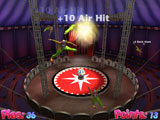
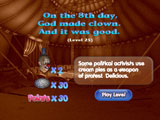
(I Hate Clowns: Operation Pie Gones Game Screenshots)
The Pie’s the Limit
For now, though, I Hate Clowns remains a simple prototype. At least this time around there’s all-new art and physics balancing to enjoy. And, hey, we’re giving the game away for free. What reason do you have not to mess up some clowns?
Download I Hate Clowns: Operation Pie Gones Game (13 MB, Windows)
Download Mac OS Version (19 MB, Universal Binary)
And if other developers are curious: We’re pretty happy with Unity. There are cons as well as pros, of course, but it does a lot of things really well. They have a free 30-day evaluation copy on their website if you’d like to try it out.
Related Posts:
- Pummel Ragdoll Clowns (Right in Your Web Browser!)
- I Hate Clowns: Let Pie Gones Be Pie Gones
- I Hate Clowns (Web Version)
- This Made My Day
- List of Physics Games



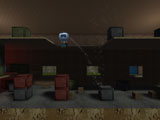
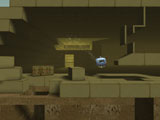

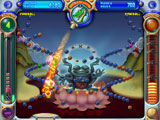
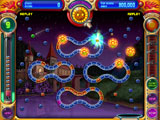
 My name is Matthew Wegner, and this site is dedicated to physics games.
My name is Matthew Wegner, and this site is dedicated to physics games.